Before COVID, more and more tech-savvy DTC companies started dipping their toes into the world of physical retail, causing a surge in interest around omnichannel retail across the board.
However, COVID certainly made an impact on the world of in-person shopping. And while foot traffic to physical stores is still down, retailers are now looking for creative ways to leverage and reposition their spaces to maximize their investments in brick-and-mortar stores.
One way they’re doing this: leveraging stores as content creation studios.
Table of Contents
What is a content creation studio?
The COVID-19 outbreak brought many challenges for the retail industry, to say the least.
While some companies saw the lockdown as a constraint, others saw it as an opportunity to redefine the store of the future. Enter the store-as-a-content-studio model.
A content creation studio is the concept of leveraging physical store space as a setting wherein creators and influencers can use the store as somewhere to create, stage, and shoot content for social media, blogs, and websites. This gives creators a place to work, but it also gives brands top-notch content they can then leverage on their social feeds.
Getting creators to shoot in your store helps consumers build associations with your brand. The more times buyers see the people they love in your store, the more chances you have of them thinking about you when they’re ready to buy.
One example of this comes from Beardbrand. It entered physical retail in 2020 to showcase the experiential side of its business, and as part of that, its on-site barbershop opened the doors to a flourishing YouTube presence.
Leveraging its store for content production allows it to not only showcase different barbershop cuts it offers, it also gives Beardbrand the freedom (and real estate) to tell stories about its products, often simply filmed on the fly with an iPhone.
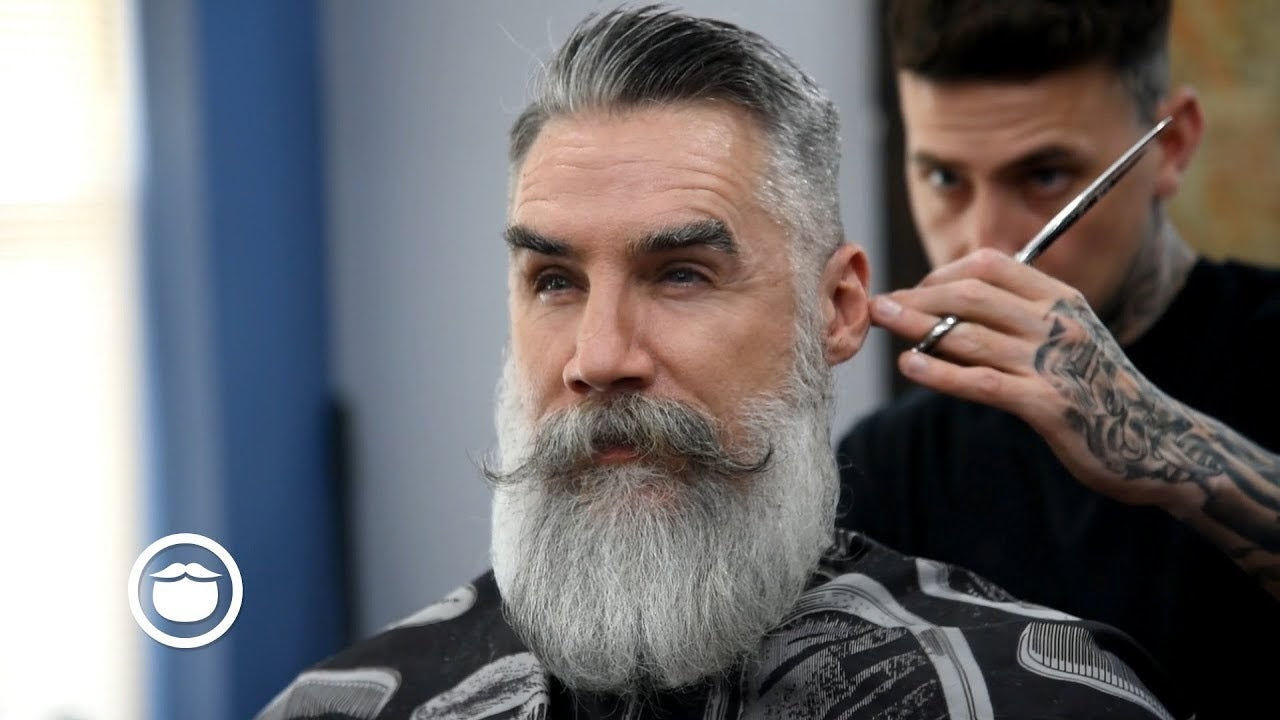
Image source: Beardbrand
Why are retailers building content creation hubs?
With stores acting as content hubs, retailers can tap into shoppers’ appetites for in-person and spontaneous live experiences. Knowing that omnichannel is the future of retail, having a content studio within a brick-and-mortar store brings some unique advantages. Let’s look at a few.
Download The Future of Retail in 2021 report
We pored over data from more than one million merchants on Shopify and collected survey insights from consumers all over the world to get the full picture of what 2021 has in store for brick and mortar retail.
Download the report1. Raise brand awareness
Creating an inviting space where influencers can make content allows brands to use top-notch original content to tap into the huge number of followers these creators have on social media.
It’s a wise play considering ever-rising CACs and crowded social feeds that make it hard for retailers to stand out amongst the noise. Repositioning a retail store as a creation studio offers a first-mover advantage and helps build brand awareness in an organic, non-intrusive way.
2. Leverage the power of influencer marketing
Wondering why all the fuss about influencer marketing? Because it works. Data from creator marketing platform Hashtag Paid shows that people engage with creator content seven times longer than digital ads. The audience trusts influencer recommendations, and brands get both content creation and distribution. It’s a win-win.
Influencers are the gateway to brand discovery in a post-COVID world. Retailers are now in the business of competing for microcults.
With the evolution of retail and changing media consumption behaviors, brands that embrace influencer marketing are the ones that stay relevant and top of mind.
As we shift toward a paywalled subscription-based model, creation is being taken more seriously, and I predict communities will become more niche. It’s helpful for a brand to build positive relationships with creators also, because the next massive media company will be influencer-based and talent-driven.
3. Build a vast library of user-generated content
Content creation is one of the biggest challenges marketers face today. The increasing need for content across channels like Instagram requires a scalable content strategy, which is where an influencer-friendly space can come into play. It’s a powerful use of user-generated content (UGC) that also acts as social proof for viewers.
I’m a big believer in any tactic or strategy that helps brands create a more scalable content strategy. Every brand struggles with the volume, velocity, and variety of content required across digital platforms. Having a co-creation model with content creators in stores is a smart way to scale word-of-mouth marketing and build community.
4. Turn customers into raving fans
Customers are hungry for authentic experiences, and it’s more important than ever to connect with them on a personal level. Even so, companies have been slow to reinvent their in-store experiences to attract customers and turn them into raving fans. Making your store a content studio can inspire more store visits and get influential ambassadors promoting your brand across social media.
Now more than ever, stores are both marketing channels and sales channels and brands that merge the two worlds.
Rebekah Kondrat explains, "Specifically for Gen Z, authenticity and personal relationships have emerged as two of the most important things for them when considering where to purchase and which brands to get behind. Adding content studios open not only to influencers but also to everyday consumers conveys that the brand is not trying to stage or manufacture its relationships."
Examples of retail stores offering content studios
Even though stores-as-content-studios is a relatively new concept, forward-thinking brands are already witnessing great results. Here’s how a few of them are using this approach.
Pottery Barn
The home furnishing store chain Pottery Barn gave influencers a $500 voucher to spend in-store while creating content about their experience. After the first phase of the campaign, they had a paid media strategy that used this influencer-generated content for retargeting customers. The campaign included nine influencers with more than one million followers combined, which gave Pottery Barn massive online exposure.
The results were jaw-dropping: the campaign drove 9,087 link clicks, a total purchase value of $90,821 AUD, and an overall return on ad spend of 1,297%.

Morphe
Despite being online-only when it first started, beauty brand Morphe entered retail space with a different approach: it launched in-store YouTube studios to encourage foot traffic and drive brand awareness with consumer-generated content.
Once they reserve the studio space to film YouTube videos, customers are offered the support of on-site staff assistance for content creation, as well as film equipment and lighting to use for video production.

Image source: Morphe
Beautycounter
Clean beauty startup Beautycounter opened a new store in Los Angeles that includes a studio where it will host livestreamed in-store experiences, makeup demonstrations, and community events.
But the store is built with an even bigger vision in mind: Beautycounter also welcomes influencers, celebrities, consultants, and even customers to use the content creation studio. For Beautycounter, this is a way of bridging the online-offline gap, but also of connecting with customers on a more personal level.
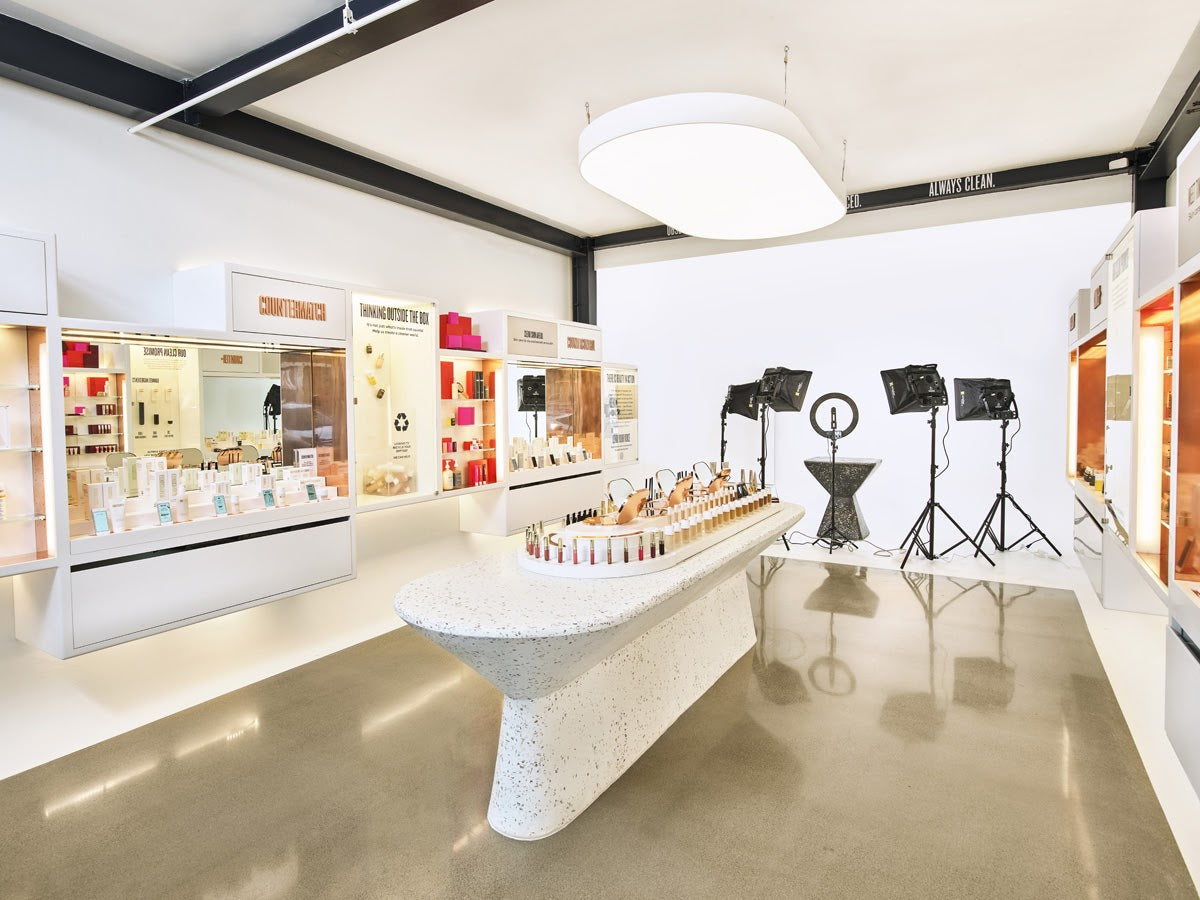
Image source: Beautycounter
Winky Lux
Winky Lux is a luxury and cruelty-free cosmetics brand aiming to redesign the beauty industry. With a seven-room-experience in New York, it completely disrupted traditional retail.
Each of the seven Instagramable rooms has been designed for customers who enjoy creating social media content. The store has a retail shop, but visitors are welcomed even if they only want to visit the content creation space. To enter these rooms, visitors pay a $10 fee. Each room has a different design inspired by a Winky Lux product.
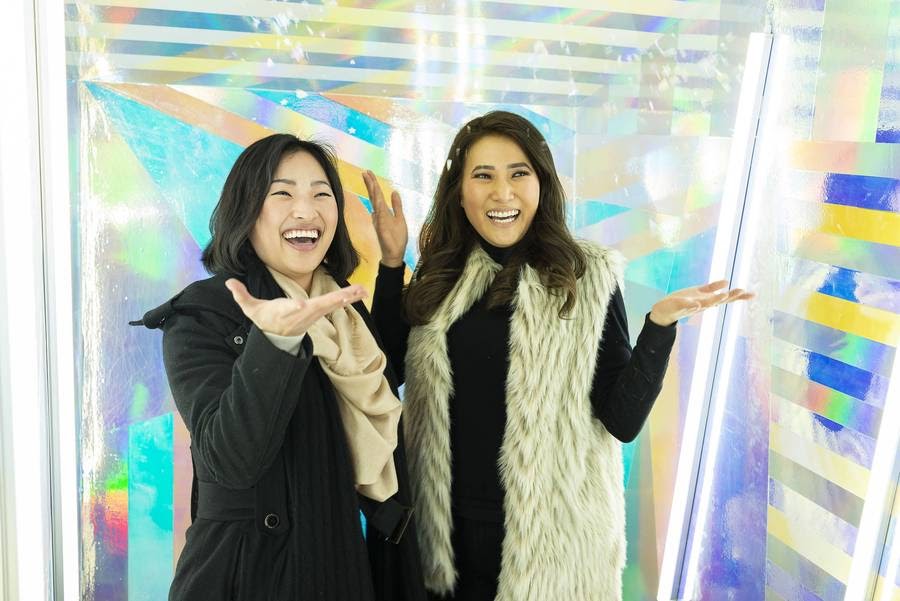
Image source: Winky Lux
Shekou Clothing
Shekou Clothing is a New Zealand–based online fashion brand for women’s clothing and accessories. Social media marketing is an essential element of its overall strategy, so it relies heavily on user-generated content.
To simplify the content creation process, it created a content room at Shekou HQ. The room is equipped with different backgrounds and ready-to-use props to help visitors create interesting content. Shekou frequently shares TikTok videos from its content room to encourage creators to visit (and shop).
@shekouclothing A lil look into our new content room at the Shekou HQ ✨💚🌸 #ColorCustomizer #shekou #roomtour #aesthetic #style #fyp #foryou
♬ Be Your Girl By Teedra Moses X Kaytranada Edition - The Favourites.
Windy City Cannabis
Medical and recreational dispensary Windy City Cannabis leverages influencer marketing to raise brand awareness. The cannabis retailer works with influencer partners sourced through Hashtagpaid’s creator marketing platform to get content creators in-store to create social content.
When it comes to unique experiences, customers look for stories they can relate to. In a campaign for Windy City Cannabis, aside from sharing information on the new store location, digital creator Keri Hill shared her story and experience as a new cannabis user.
SHOWFIELDS
SHOWFIELDS is an innovative retail concept built to engage customers and reimagine the shopping experience. Its retail space brings together unconventional brands, artists, and communities from around the globe.
The moment you step inside, you can tell SHOWFIELDS is dedicated to creating the“most interesting store in the world.” It’s not about the content, it’s about the stories.
"From the inception of SHOWFIELDS there was a strong vision to merge art and commerce. To do this, when we design our brand activation spaces, we look at them as stages for both artists and creators in our community to exhibit their emerging artworks and mission-based brands. Influencers are looking for content to share. The only incentive we can do is try and tell a compelling story, and do it in a way that makes other people want to share. We do not create Instagrammable spaces for the sake of someone coming to take a picture. We believe in storytelling." — Tal Zvi Nathanel, SHOWFIELDS CEO
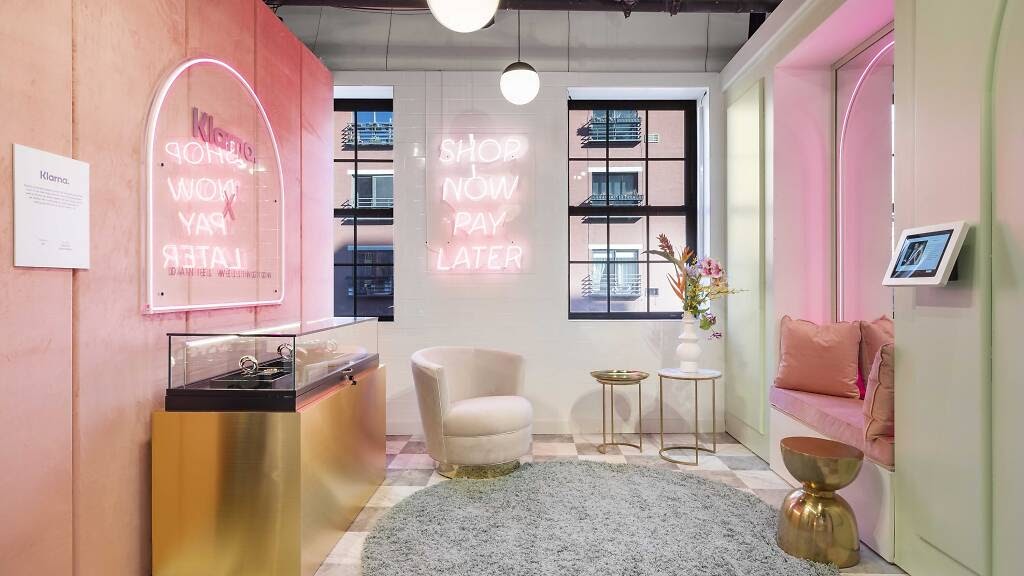
Image source: Showfields, Eitan Gamlieli
Nike
Legacy sportswear company Nike is constantly introducing different retail experiences. One example: Nike and the Hovercraft Studio team launched an interesting retail activation at Nike’s House of Innovation that leveraged a web-native AR experience that brings the stories behind its new line of products to life.
The experience was designed around a geofenced microsite called Basecamp that allowed visitors to use their own mobile devices. An AR and QR scavenger hunt invited visitors to discover the wildlife native to Smith Rock. After completing the digital game, visitors got a limited edition bundle of new products in the new collection.
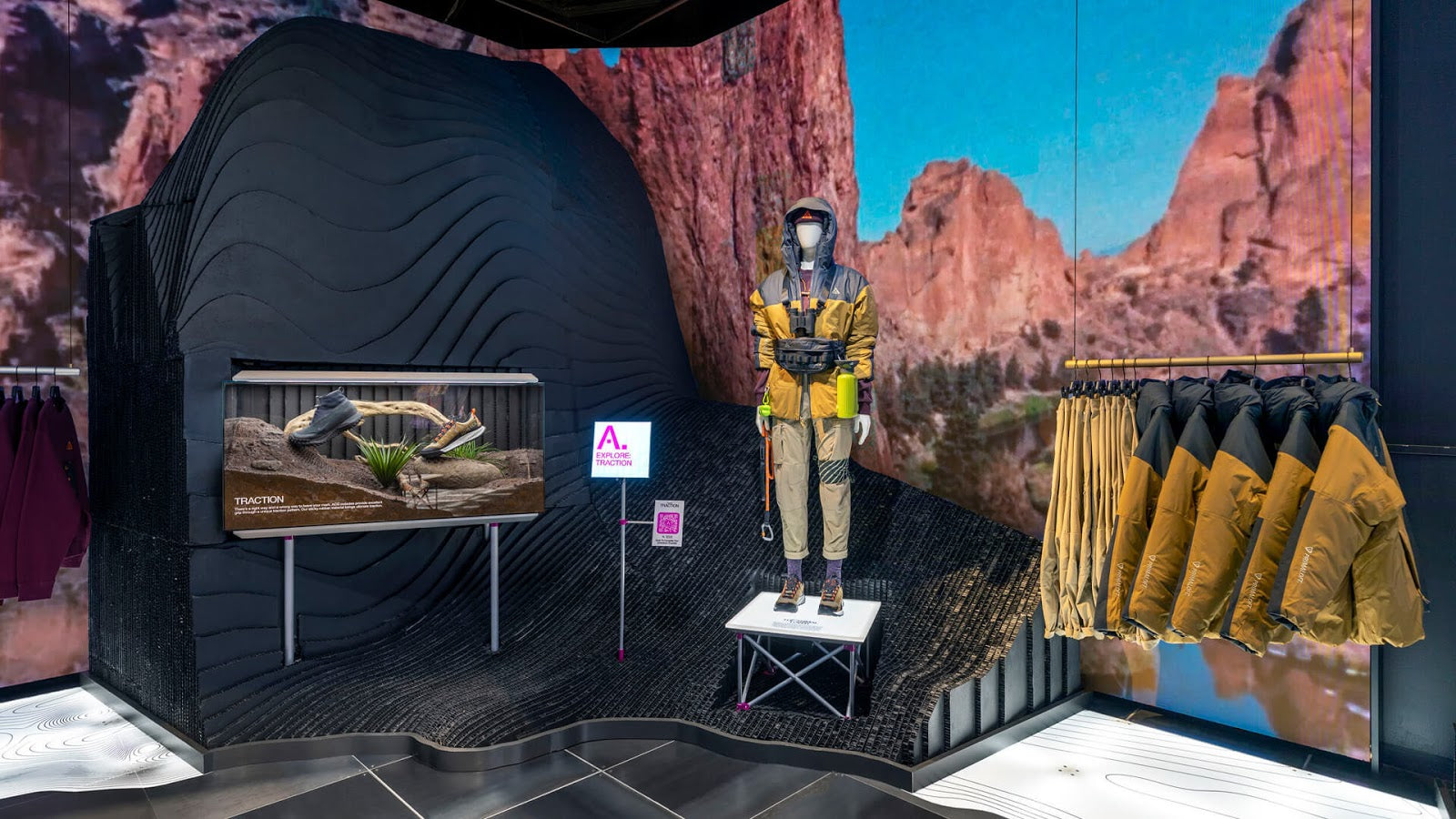
Image source: Hovercraft Studio
Can all retail store owners position their spaces as content studios?
Many retailers are discouraged by the thought that creative formats such as content creation studios are only for large companies with deep pockets. But this is far from the truth. Don’t underestimate the creativity of small businesses, especially during challenging times.
If there is one thing I learned during COVID, it’s to never bet against the creativity and ingenuity of small businesses. Small brands can still integrate UGC with their store initiatives by executing a localized approach to content.
It’s time to bust the myth that content creation hubs are reserved only for well-resourced brands.
How to leverage physical retail space as a content creation hub
If you’re on the quest to turn part of your retail store into a content creation studio, take these suggestions into account.

Image source: Brandon Moore at Koko x Forage in Louisville, KY
When designing our Koko refilleries, I wanted people to experience our core values—approachability, fun, and sustainability—from the moment they stepped foot in our shop, and incorporating unique sayings and art pieces that reinforce this also invites customers to photograph their experience while they’re there.
- Turn the store into a destination. To attract more visitors, you have to create eye-catching, appealing experiences. Digital natives are hungry for rich in-store experiences. Eight in 10 Gen Z and millennial internet users in the US feel it’s important for a brand to operate a brick-and-mortar location. Build appealing, instagramable experiences and visitors will come.
- Train your staff. Having a well-trained staff that welcomes creators is critical for a content creation hub’s success. Team members should act as production assistants and share best practices, tips, and tools to foster content creation.
- Make it easy to create UGC. If you want to test an in-store content studio, you have to make it easy for visitors to create content. From backdrops and lighting equipment to interactive mirrors, props, and branded hashtags—be strategic about making it easy to snap photos and videos in-store.
- Offer whole-store space bookings. Aside from having a dedicated content creation space, you can also offer a whole-store booking, wherein creators can have full use of your store, leveraging appointment scheduling tools. This unlocks next-level user-generated content that’s invaluable for brand awareness.
Simplify logistics of the space and spell out what will be included. I’d imagine many of the creators will be coming in-store without a big setup of their own, meaning some equipment and setup needs to be done for them.
Planning required for the store-as-a-content-studio model
If you’re on board with having a content creation hub inside your store, you need some planning to create a seamless, enjoyable experience.
Even though you’re free from the heavy-lifting in terms of content creation, there are some minimum requirements that you need to take care of before cutting the red ribbon and welcoming visitors.
Establish space usage guidelines
First and foremost, you have to decide if you’ll only rent the space to creators who want to create for you or if it’s a regular, free-to-anyone studio. If you choose to go with the first approach, bear in mind usage rights and document your policy. As Grace Clarke says, “Usage rights are a migraine. The content is more helpful if brands can repurpose it.”
"We’ve all grown accustomed to offering any creative output for free, and we’ve been trained that no one owns anything on the internet. But that’s not true. Even the creator and the brand aren’t the sole beneficiaries of this. Google and Facebook and Pinterest derive enormous benefit from the content being there, being searchable, driving up engagement on the platforms. Professionalizing the creator pursuit in this way is ultimately a net benefit for the industry and the economy." — Grace Clarke, Brand and marketing consultant
Create a documented approval process for creative content
When it comes to leveraging user-generated content, different brands have different approaches. If you want authentic customer content, you only need a high-level approval process. However, if you want high production and have more content creation studios, you need a more detailed documented approval process.
Brands that trust their customers and employees can put content guidelines in place and have a high-level approval process before anything posts.
However, Kondrat cautions, "But, brands that want high production value on each and every video might struggle to build a sustainable infrastructure, especially if they have multiple stores with content studios. Ultimately, this will come down to how much revenue and brand loyalty these experiences drive. Brands will have to test it to know for sure."
Plan for when foot traffic to physical stores picks back up
Predicting what will happen in 2021 for brick-and-mortar stores is anyone’s guess. However, it is safe to say that the foot traffic will likely start to pick up with time.
If you plan on opening a store-as-a-studio model, you need to factor in the logistical challenges in managing a retail business and a content creation studio simultaneously.
You’re essentially running two businesses in one, which is fine in the current situation while traffic is still down about 20% in stores. If foot traffic picks back up—and early signs say it will—stores will have to learn the logistics of running a studio and a loud busy store side by side.
Rethinking your retail space for 2021
A new era of retail is about to unfold, and now is the time to embrace it. Using stores as content studios can help you drive traffic, build customer relationships, and raise brand awareness, all while boosting your bottom line.
The next decade will reward forward-thinking retailers ready to pivot and meet ever-changing customer expectations. If you want to get a peek into the future of retail, download our report.
